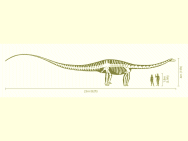Name: Diplodocus
Phylum
Chordata, Class Sauropsida, Superorder Dinosauria, Order Saurischia, Suborder
Sauropodomorpha, Infraorder Sauropoda, Family Diplodocidae
Geological
Time: Upper Jurassic, Kimmeridgian and Tithonian stages (~150 m.y.a.)
Size: up
to about 90 feet long
Stratigraphy:
Western United States and Canada
 Diplodocus
is a genus of sauropod dinosaur that was first discovered in 1878.
The name derives from double chevron-shaped bones underneath the
tail. Diplodocus
is a genus of sauropod dinosaur that was first discovered in 1878.
The name derives from double chevron-shaped bones underneath the
tail.
Diplodocus is one of the more common Jurassic dinosaurs found in
what is now western North America, and particularly in the Morrison
Formation of the western United States and Canada, which dates
to some 150 to 147 million years ago. During this period, the area
was dominated by huge sauropod dinosaurs such as Camarasaurus, Barosaurus,
Apatosaurus and Brachiosaurus. Diplodocus was for many years the
longest known dinosaur, and its size alone may have deterred predation
from such fierce predators as Allosaurus
and Ceratosaurus, whose remains are found in the same region.
|
|


